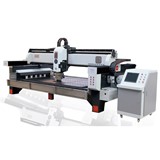Organisers of a national conference that will seek to define job quality say Australia is at risk of mimicking the United States as it moves towards a polarised society with a highly paid group of people and a large underbelly of workers in unsustainable, unsatisfying, high turnover jobs.
"It's becoming very difficult now for workers at the bottom of the ladder to aspire to better paid and more satisfying middle ranking jobs in the manufacturing sector or to do an apprenticeship, become qualified tradespeople and move into jobs that were once highly desirable," Professor Chris Warhurst said.
Along with the demise of manufacturing, Professor Warhurst says job quality has been severely eroded by a decline in the trade union movement which once ensured that jobs were protected and that working conditions, training, wages levels and opportunities for career development were maintained.
The recent 'Expert Conference on Job Quality in Australia' hosted by the University of Sydney Business School, will attempt to identify ways that federal and state governments can address the decline in job quality.
A guest speaker at the conference and a leading US expert on employment and job quality, University of North Carolina's Professor of Sociology, Dr Arne Kalleberg, warns that Australia could follow the US, where a quarter of those who work full-time earn less than the poverty level for a family of four.
"Many of the jobs that now exist in the US are bad jobs, paying low wages, offering few benefits, and providing workers with little flexibility and satisfaction," Professor Kalleberg who is the author of the recently published Good Jobs, Bad Jobs: The Rise of Polarized and Precarious Employment Systems in the United States, said.
"With the decline of manufacturing in the US, most of the new jobs created in the past few years are in low-wage occupations and industries such as retail sales, food preparation and personal and home health care aides," he said.
"In recent decades, the focus has shifted away from job quality to job quantity and too many people are now in work that is precarious, insecure and unable to provide a decent standard of living," the Business School's Dr Angela Knox, said.
"Just as in the last big economic downturn in the 1970s, many countries have now shifted their emphasis from generating better jobs to simply creating any jobs. It's job creation, not job quality that's the focus," Dr Knox said.
"This approach was flawed in the 1970s, and it is now, creating neither good jobs nor sustainable jobs. It's a situation we need to avoid in Australia."
Dr Knox says that the overwhelming focus on industrial relations policy has diverted attention away from other equally important levers that should be addressed to create better quality jobs.
"It is now time for government, business and unions to work together to improve education and training and to develop economic and industry conditions that support good jobs," she said.
"Rising employment participation rates in Australia make the quality of work an increasingly important policy focus," Professor Warhurst added.
"Job quality can affect general life satisfaction, health and family life as well as productivity, turnover rates and absenteeism."














